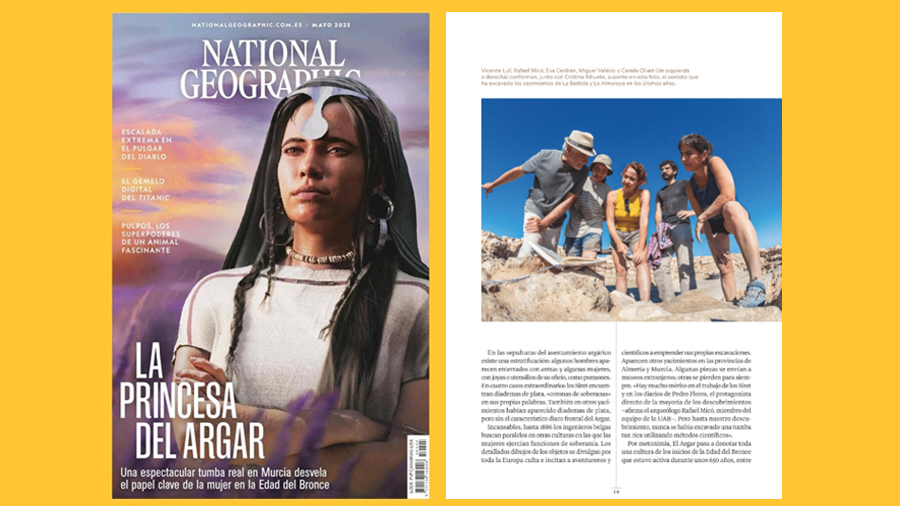The Research on El Argar and the Princely Tomb of La Almoloya Featured in National Geographic
National Geographic magazine has dedicated the main article of its May issue to the research and discoveries made by the research team of the Social Archaeology of the Mediterranean (ASOME) group at the UAB at the sites of La Almoloya and La Bastida, which are representative of the El Argar society that inhabited the southeastern Iberian Peninsula 4,000 years ago. The publication has also devoted its editorial and cover to the topic, featuring an illustration of the Princess of La Almoloya.

To produce the feature, the magazine’s editor-in-chief, Gonçalo Pereira, traveled with the Almoloya-Bastida Project team to the southeast of the Iberian Peninsula, immersing himself in what was one of the most emblematic societies of our prehistory: El Argar. Guided by the project coordinators—Vicente Lull, Rafael Micó, Camila Oliart, Cristina Rihuete, and Miguel Valério from the UAB, along with Eva Celdrán from the University of Murcia (UMU)—he explored 700 years of a powerful society that, despite extensive research, still holds many unresolved mysteries.
One of the most distinctive elements of Argaric society (2200–1550 BCE) is the practice of burying the dead directly beneath the houses. These burials are not only remarkable for the exceptional preservation of grave goods, but also because the study of these materials, artifacts, and skeletons has shed light on important aspects such as social organization. For five centuries (2000–1550 BCE), the inhabitants of a vast territory—spanning Alicante, Murcia, Almería, Granada, and Jaén—shared the same funerary practices, which reveal class distinctions, inheritance systems, and gender roles. The discovery of Tomb 38 at La Almoloya in 2014, along with ongoing research, is a prime example of what Argaric society may have been like. This tomb belonged to a young woman buried with a silver diadem and other unique objects that set her apart—not only from other burials, but even from the man buried alongside her, with whom she had a daughter. This has led researchers to suggest that she may have played a significant political role in the governance of El Argar. Based on this hypothesis of female leadership, illustrator Joana Bruno—who earned her PhD as part of the Almoloya-Bastida project—was commissioned to create the cover for the May 2025 edition.
Gonçalo Pereira delves into the latest research and offers a broad perspective on El Argar. The article is accompanied by photographs from Núria Puentes, who traveled to Murcia last summer to document firsthand the excavation work being carried out at the La Almoloya site (Pliego) by the research team. The excavation included undergraduate students from the University of Murcia, master’s students from the UAB, and other graduate volunteers from Madrid. She also visited the La Bastida site (Totana), capturing stunning images of a settlement that may have housed up to a thousand inhabitants. At La Bastida, researchers have identified one of the most impressive Bronze Age fortifications in the Iberian Peninsula, as well as a massive reservoir capable of holding 350,000 liters of water.
The article also includes virtual recreations, such as Dani Méndez’s (Revives) reconstruction of La Bastida at its peak, and Pixeldreams' digital models of La Almoloya, including a scene depicting what the H9 area—also known as the “meeting hall” or “parliament”—may have looked like. This 130-square-meter room features an extensive bench that could seat around fifty people and may represent a unique political space, especially since Tomb 38 was found there.
In his article, Gonçalo Pereira highlights the need for institutional commitment to preserving and disseminating knowledge about this archaeological and cultural heritage. He concludes by pointing out the many unanswered questions that still surround El Argar.
Reference article: Gonçalo Pereira (text) and Núria Puentes (photography). “La Princesa del Argar,” National Geographic, May 2025. https://www.uab.cat/doc/LaPrincesadelArgarNationalGeographic